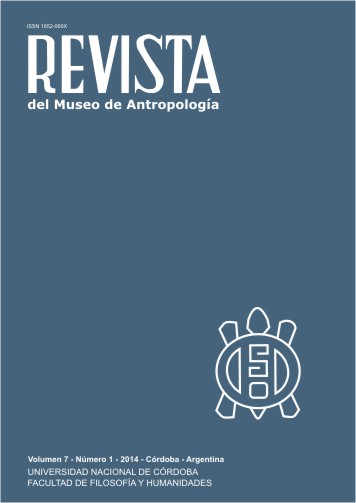To die for Platense. Adversity and temporality as perceptive structures between football supporters
DOI:
https://doi.org/10.31048/1852.4826.v7.n2.9190Keywords:
adversity, temporality, identity, habitus, football, supporters, violence, “aguante”Abstract
In this article there will be shown two different perceptive structures that appear in a group of football supporters identified with Platense, team located in the north of Buenos Aires City which currently plays at the third division. Since the death of a twenty year-old youth who belonged to the group, between 2009 and 2011 the author developed an ethnographical study in which analyzed identity as a generator of violence, their relationship with territories and discourses regarding death. Among that study it became possible to make an approach to two perceptive structures: the idea of being constantly dealing with the adversity and a strongest power, and the relationship with time. In this second case, we are able to demystify the current belief of a present preponderance. As a result, it’s also possible to make an approach to the influence of death in their ways of living.Downloads
References
Alabarces, P., Garriga Zucal, J. 2007. “Identidades corporales: entre el relato y el aguante”. Campos. Revista de Antropología Social, vol. 8, Issue 1, pp. 145-165
Bourdieu, P. 2010. El sentido práctico. Buenos Aires: Siglo Veintiuno Editores.
Castoriadis, C. 1998. Lo imaginario: la creación en el dominio histórico-social. Los dominios del hombre. Las encrucijadas del laberinto. Barcelona: Gedisa.
De Certeau, M., Giard, L. 1996. La invención de lo cotidiano. 1. Artes de hacer. Introducción general, II: Culturas populares; III: Valerse de: usos y prácticas; IX: Relatos de espacio. México: Universidad Iberoamericana.
Elbaum, J. 1998. Apuntes para el ‘aguante’. La construcción simbólica del cuerpo popular. Alabarces, Di Giano y Frydenberg (Comp.). Deporte y Sociedad. Buenos Aires: Eudeba.
Diez, P. 2006. “Ni careta ni quemado, rescatado. Usos del cuerpo, adscripciones identitarias y morales de jóvenes varones de Bajo Flores, Ciudad de Buenos Aires”. Instituto de Desarrollo Económico y Social, Instituto de Altos Estudios Sociales, Universidad Nacional de General San Martín, Argentina. Tesis de Maestría en Antropología Social.
Garriga Zucal, J. 2005. Lomo de macho. Cuerpo, masculinidad y violencia de un grupo de simpatizantes del fútbol. Cuadernos de Antropología Social nº 22. Buenos Aires.
Garriga Zucal, J. 2007. Haciendo amigos a las piñas: violencia y redes sociales de una hinchada de fútbol. Buenos Aires: Prometeo Libros.
Gil, G. J. 2002. Fútbol e identidades locales. Dilemas de fundación y conflictos latentes en una ciudad “feliz”. Buenos Aires: Miño y Dávila editores.
Moreira, M. V. 2005. “El Rojo y Newell’s Old Boys, un solo corazón”. En: Alabarces, P. (Comp.). Hinchadas. Buenos Aires: Prometeo.
Vázquez, M. 2000. “Ser joven Ser varón Ser pobre. La Mortalidad por causas violentas en los adolescentes del conurbano bonaerense”. Ponencia en las Jornadas Gino Germani. IIFCS. Buenos Aires: Instituto de Investigaciones Gino Germani.
Downloads
Published
Issue
Section
License
Those authors who have publications with this Journalaccept the following terms:
a. Authors will retain their copyrights and guarantee the journal the right of first publication of their work, which will be simultaneously subject to the Creative Commons Attribution License (Licencia de reconocimiento de Creative Commons) that allows third parties to share the work as long as its author and his first publication in this journal.
b. Authors may adopt other non-exclusive licensing agreements for the distribution of the version of the published work (eg, deposit it in an institutional electronic file or publish it in a monographic volume) provided that the initial publication in this journal is indicated.
c. Authors are allowed and recommended to disseminate their work on the Internet (eg in institutional telematic archives or on their website) before and during the submission process, which can lead to interesting exchanges and increase citations of the published work. (See The Effect of Open Access - El efecto del acceso abierto)












